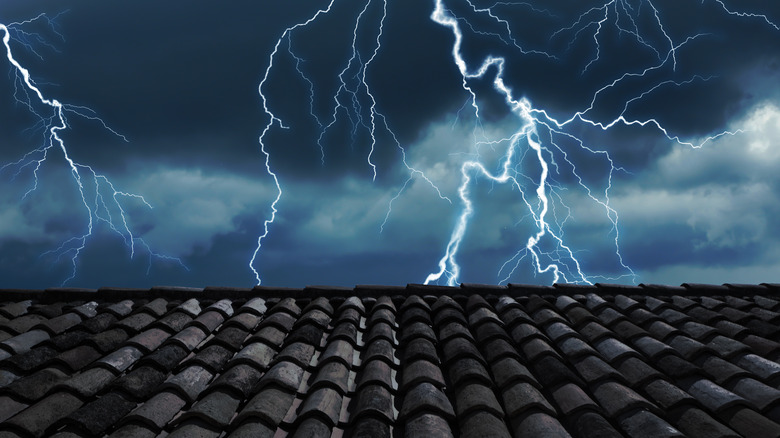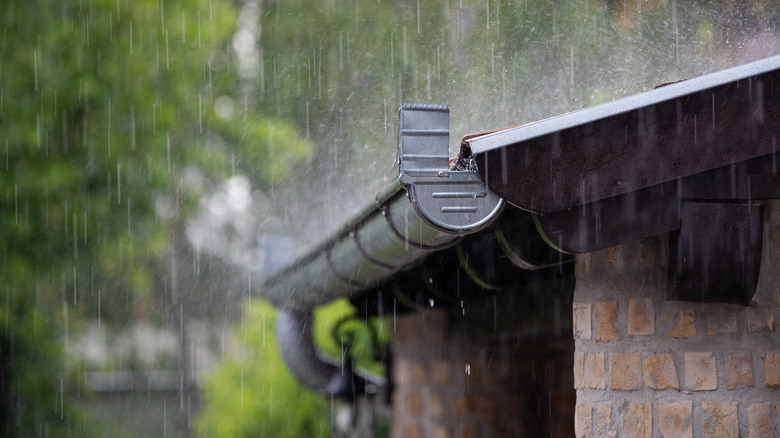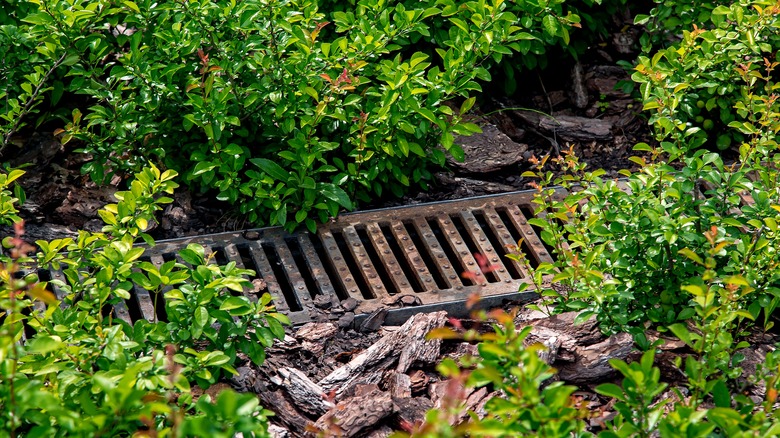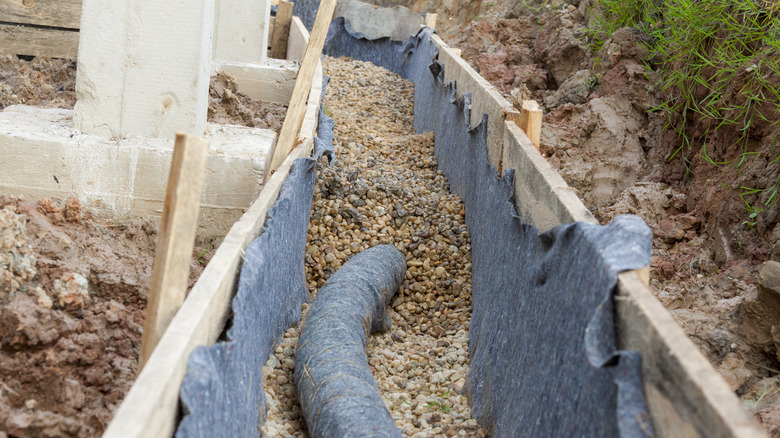The 4 Best Stormwater Drainage Solutions For Your Home
Excessive stormwater runoff is an increasingly important factor in home design. According to Deeproot, thanks to the increased frequency and severity of major storm events, managing the associated water has been a challenge that many leaders in urban design have taken on in past decades.
While the idea of minor flooding is commonly accepted, higher than average rainfall can lead to large scale property damage, per Penn State Extension. If left unchecked, exceptional levels of stormwater can do unseen damage to foundations. It can cause rising dampness to seep up through floors and into walls, and it can lead to deterioration around windows and doors. Drainage solutions are almost always cheaper to install than would be replacing fundamental parts of your home after they've suffered damage.
Then there's the possibility of damage to any land surrounding your house and the wider environment. As Columbia University Climate School points out, stormwater runoff is adept at scooping up whatever it comes into contact with. This could mean washing all of your topsoil away, and leaching nutrients and fertilizers from your yard; all of which will be dumped into waterways where they can cause algae problems and a form of pollution called eutrophication, which depletes oxygen.
Given the many hazards of stormwater, it's important to manage it responsibly to reduce cost, stress, and damage to your property. Here are four stormwater drainage solutions to keep your basement from flooding or worse.
Starting from the top — downspouts and gutters
A structurally sound and well-maintained roof is your best safeguard for protecting yourself, your family, and your stuff from excess rain. However, all of the rain that would otherwise be falling on your TV room has to go somewhere, right? Per Gardner's Supply Company, for a 1,000 square foot roof, a ½ inch of rainfall is the equivalent of 300 gallons of water.
All of that water hits your roof, runs along whatever angle the wind and gravity are taking it that day, and drops straight down. Left to puddle and stagnate, it will very quickly cause issues with your foundation. According to Designing Buildings, many building codes recognize this and that is why most require structures to have some form of gutters as well as a rainwater downpipe. Gutters run around the edges of the roof to collect water as it runs off and direct it safely towards the downpipe.
The downpipe shouldn't just take water from the roof to surface level, according to Home Inspection Insider. A downpipe needs to be positioned to deliver rainwater at least 10 feet from the house to avoid damage to foundations or basement walls. The number and location of downpipes that you'll need will vary with climate and home size, but a well-worn rule of thumb is that each individual downpipe should be responsible for draining no more than 35 feet of gutter. You could also add a rain barrel to harvest the water.
Surface level — channel drains
For a force as destructive and disruptive as water can be, it is thankfully, remarkably consistent. This allows us to plan our designs around its behavior. Water can't go through waterproof surfaces. It can't flow uphill without a pump, and it always finds it easier to flow through bigger gaps than smaller ones. Armed with these facts, we can make effective drains.
Channel drains are sometimes called trench drains or ACO drains, after the brand name of the leading manufacturer of these kinds of drainage solutions, according to AVS Fencing. They are ubiquitous in city centers and shopping malls and can be thought of as gutters for the floor, with a grate to stop large bits of debris from falling in and blocking the drain. Channel drains are also very useful in a residential setting, as they are strong, simple, and relatively inexpensive to install.
According to ABT, Inc., a channel drain is designed to deal with surface-level water by providing a concrete-lined, downward-sloping channel that whisks water away from where it's not wanted. This could be as simple as connecting your gutter downpipe to a natural stream, to the local storm drain, or your own specially designed pit. Thoughtfully and methodically adding more channel drainage to your property will make it more storm resilient by decreasing the amount of surface water that has a chance to soak into the ground or damage your foundation.
Going underground - French drains
Unfortunately, not all water is surface water. Many of the most expensive and dangerous impacts of stormwater happen underground. Stormwater can soak into the ground at higher elevations than your home, and then flow through the soil beneath the surface and cause extreme damage to any subsurface structures such as basements or foundations. According to T. Lake Environmental Design, a French drain (named after the inventor, not the nationality), is an underground structure designed to tackle issues with subsurface drainage.
Per the DIY Doctor, these systems aren't meant to replace surface drainage but are especially useful where water tends to build up against walls or buildings. A typical French drain will involve digging a trench, then backfilling it with various gradations of gravel. A perforated pipe is placed into the trench, within the gravel layers. Typically this pipe is coated in some sort of filtration membrane to keep particulates from clogging the French drain. As with any drain, there will be a minor slope factored into the design to encourage flow from the saturated areas to wherever's best for the water to be directed.
As explained by Drainage Superstore, the layers of gravel extract excess water from surrounding soil through air pockets that attract subsurface water. This means that once the water has reached the French drain, it's not going to circulate back into the soil until it's meant to.
Closing the drainage loop - dry wells and rain gardens
If your local jurisdiction is lenient in terms of drainage, all you need to worry about is draining water away from your home. However, it could also be the case that you are required to create an outlet area. If there's no obvious place 10 to 20 feet from your home for your channel or French drains to discharge into, then, instead of just allowing the land downhill from your home to be waterlogged, consider creating a rain garden or installing a dry well.
Rain gardens, according to the Maryland Department of the Environment, temporarily retain stormwater after a rainfall event. They are made up of plants, mulch, soil beds, and grasses that thrive in wet conditions. A well-designed rain garden can be a visually appealing treatment filter for stormwater that has been flowing over rooftops and driveways before allowing it to slowly reenter the water supply.
Similar to rain gardens though not nearly as attractive, dry wells are simple, excavated pits that facilitate the temporary storage of stormwater runoff. Studies show that in addition to helping with stormwater drainage issues in wet areas, dry wells can also help recharge aquifers in areas with drought. Good drainage can save you on home repairs, great drainage can help repair the environment in which you live.




